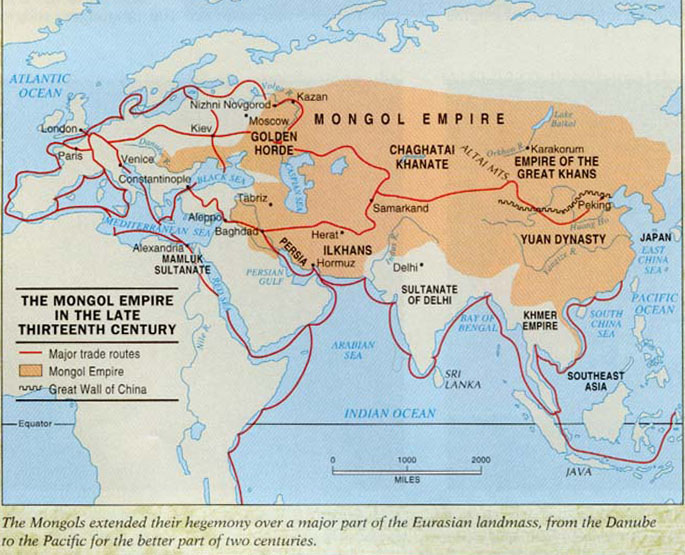Thank Genghis for Your iPhone: Cultural Carriers and Your Business
Almost 900 years ago, Genghis Khan and the Mongols created the largest empire in history thanks to their ability to act as cultural carriers.
In a moment of political acrimony, remember the value in sharing ideas and learning from other disciplines, businesses, and cultures. As history proves, the best companies — and empires — reach across the aisle.
Building an iPhone the Mongol Way
No one knows how to build our most amazing technologies.
That is to say, a single individual could not design the motherboard, mold the plastic, install the battery, or develop the software needed to build an iPhone. Instead, it requires a combination of talents to create this amazing product.
The Mongols understood the idea of sharing skills better than any other civilization in the 13th and 14th centuries (and maybe before or since). As author Jack Weatherford notes in the book Ghenghis Khan and the Making of the Modern World:
The Mongols made no technological breakthroughs, founded no new religions, wrote few books or dramas, and gave the world no new crops or methods of agriculture. Their own craftsmen could not weave cloth, cast metal, make pottery, or even bake bread. They manufactured neither porcelain nor pottery, painted no pictures, and built no buildings. Yet, as their army conquered culture after culture, they collected and passed all of these skills from one civilization to the next.
The Mongolian Renaissance
The Mongols have the reputation of being ruthless conquerors or even savages, thanks in large part to the rewriting of history books by Europeans in the Renaissance Era.
The Mongols were indeed violent, offering conquered cities the option of surrender or total annihilation if they resisted. As rulers, however, they were incredibly tolerant, protecting religious freedom for their subjects and encouraging education and literacy with universal basic education for all children.
As their empire grew from Southeast Asia to Egypt to Hungary and all the way across Russia, they forever altered civilization. In fact, the entire European Renaissance, according to Weatherford — including technology, clothes, commerce, food, art, literature, music, and more — was a result of Mongol influence.
How does a culture that didn’t know how to do any of this on their own improve civilizations across Eurasia?
The answer is sharing. The Mongols were the preeminent cultural carriers, combining the knowledge from previously conquered civilizations with the new skills they found.
“The Mongols brought German miners to China, Chinese doctors to Persia and Persian engineers to Russia,” says Weatherford. “They transplanted lemons and carrots from Persia to China, and brought noodles, playing cards and tea to the West.”
Right behind their soldiers at battle was a battalion of engineers, mathematicians, and scholars. They would encounter new forms of military defensive, such as fortresses in Europe, and would merge technologies for new solutions to win the battle.
As Weatherford notes, “Their engineers combined Chinese gunpowder with Muslim flamethrowers and applied European bell-casting to create the cannon . . . from which sprang the vast arsenal of weapons from pistols to missiles.”
Avoiding Insider Bias with Termite Mounds
Political and military empires are not the only place to find cultural carriers.
Transformative businesses use the same tactic, learning from other industries and companies, to create new approaches to solving a problem. These “blue ocean strategies” develop products and services that are true trailblazers, often spawning entirely new industries and best practices.
Amazon succeeds by combining the lessons of Walmart with technology. Office buildings in Harare are cooled by fusing the self-cooling science of termite mounds with modern building materials. Rural communities support entrepreneurship by connecting lessons from local churches with technology.
Innovators naturally look at problems differently than established players. They look from different angles and perspectives that more experienced individuals might believe will never work.
For this reason, change is often slow to occur in an industry. New ideas and products are discarded or invisible to people with “insider bias.”
Innovators, outsiders, and cultural carriers avoid insider bias by looking at problems from a different perspective. No strategy or tool is off limits. They may have less training or unorthodox credentials, but this serves them well because they are not afraid to challenge or reconsider group assumptions.
In other words, cultural carriers are the perfect instigators of innovation.
Dominate as a Cultural Carrier
Weatherford writes, “In twenty-five years, the Mongol army subjugated more lands and people than the Romans had conquered in four hundred years. . . . Genghis Khan conquered more than twice as much as any other man in history.”
The Mongols’ success was greater and longer lasting than previous empires not because they were elite warriors (which they were). Instead, they ruled the world because they focused on combining knowledge and writing their own rules. There was no bias to how they could solve a problem or conquer a foe.
We, too, can write our own rules as businesses and innovators. The Mongols learned that “victory did not come to the one who played by the rules; it came to the one who made the rules and imposed them on his enemy.”
Reach outside of your industry and culture. The fusion of ideas will help you write the rules and build your empire.
Banner image: Time Magazine


